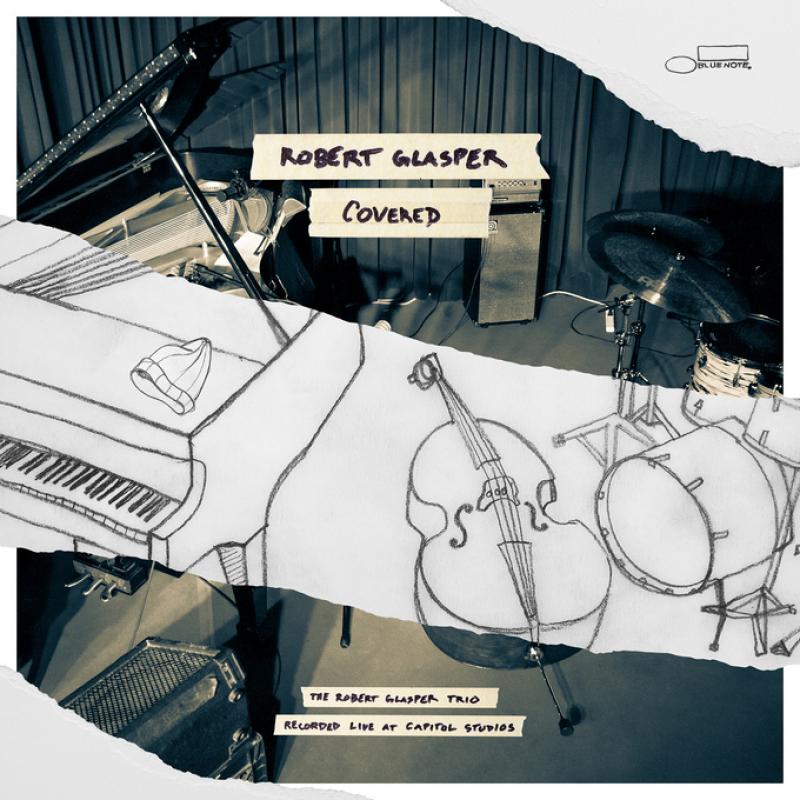CD: Robert Glasper – Covered | reviews, news & interviews
CD: Robert Glasper – Covered
CD: Robert Glasper – Covered
New material gets vintage jazz treatment as Glasper marks ten years at Blue Note

Robert Glasper has recently been making a name, and winning Grammys with his electronic fusion outfit, the Robert Glasper Experiment. After years of Casey Benjamin’s croaking vocoder on the Black Radio albums, the pealing acoustic notes of Glasper’s conventional trio are almost a surprise. Also novel by Glasper’s standards is the source material: there’s only one standard, “Stella By Starlight”. Many of the rest of are, as the title suggests, covers.
Glasper’s caustic frustration with the jazz world’s navel-gazing (“I feel like jazz needs a big-ass slap,” he wrote in DownBeat in 2012) might imply a radical approach, but in many cases Glasper plays it fairly straight. For all the novelty of the choices, Glasper’s concept of jazz technique is appealingly traditional, with firecracker solos and outbursts of vigorous melody like the rainbow after the storm. Joni Mitchell’s “Barangrill”, Radiohead’s “Reckoner” and Musiq Soulchild’s “So Beautiful” have a charming melodic lilt, their themes left to speak for themselves, with only a subtle Glasperisation. “Stella By Starlight”, by contrast, is worked over much more rigorously, in keeping with its jazz familiarity.
Belafonte’s contribution, a defiant assertion of black cultural identity, and the closing song, Lamar’s “I’m Dying of Thirst”, in which children recite the names of black victims of police shootings, are both unimpeachable statements, but the use of the very old and very young can’t help but verge on the mawkish. Yet here, as with the arrangements, there’s something refreshingly clear-eyed about Glasper’s approach. In many ways, this album recalls the time jazz was a genuinely popular music, with tunes, virtuosity, and something important to say.
rating
Share this article
The future of Arts Journalism
You can stop theartsdesk.com closing!
We urgently need financing to survive. Our fundraising drive has thus far raised £49,000 but we need to reach £100,000 or we will be forced to close. Please contribute here: https://gofund.me/c3f6033d
And if you can forward this information to anyone who might assist, we’d be grateful.

Subscribe to theartsdesk.com
Thank you for continuing to read our work on theartsdesk.com. For unlimited access to every article in its entirety, including our archive of more than 15,000 pieces, we're asking for £5 per month or £40 per year. We feel it's a very good deal, and hope you do too.
To take a subscription now simply click here.
And if you're looking for that extra gift for a friend or family member, why not treat them to a theartsdesk.com gift subscription?
more New music
 Solar Eyes, Hare & Hounds, Birmingham review - local lads lay down some new tunes for a home crowd
Psychedelic indie dance music marinated in swirling dry ice
Solar Eyes, Hare & Hounds, Birmingham review - local lads lay down some new tunes for a home crowd
Psychedelic indie dance music marinated in swirling dry ice
 The Lemonheads' 'Love Chant' is a fine return to form
Evan Dando finally gets back in the saddle with an album of new tunes
The Lemonheads' 'Love Chant' is a fine return to form
Evan Dando finally gets back in the saddle with an album of new tunes
 Music Reissues Weekly: Evie Sands - I Can’t Let Go
Diligent, treasure-packed tribute to one of Sixties’ America’s great vocal stylists
Music Reissues Weekly: Evie Sands - I Can’t Let Go
Diligent, treasure-packed tribute to one of Sixties’ America’s great vocal stylists
 'Deadbeat': Tame Impala's downbeat rave-inspired latest
Fifth album from Australian project grooves but falls flat
'Deadbeat': Tame Impala's downbeat rave-inspired latest
Fifth album from Australian project grooves but falls flat
 Heartbreak and soaring beauty on Chrissie Hynde & Pals' Duets Special
The great Pretender at her most romantic and on the form of her life
Heartbreak and soaring beauty on Chrissie Hynde & Pals' Duets Special
The great Pretender at her most romantic and on the form of her life
 The Last Dinner Party's 'From the Pyre' is as enjoyable as it is over-the-top
Musically sophisticated five-piece ramp up the excesses but remain contagiously pop
The Last Dinner Party's 'From the Pyre' is as enjoyable as it is over-the-top
Musically sophisticated five-piece ramp up the excesses but remain contagiously pop
 Moroccan Gnawa comes to Manhattan with 'Saha Gnawa'
Trance and tradition meet Afrofuturism in Manhattan
Moroccan Gnawa comes to Manhattan with 'Saha Gnawa'
Trance and tradition meet Afrofuturism in Manhattan
 Soulwax’s 'All Systems Are Lying' lays down some tasty yet gritty electro-pop
Belgian dancefloor veterans return to the fray with a dark, pop-orientated sound
Soulwax’s 'All Systems Are Lying' lays down some tasty yet gritty electro-pop
Belgian dancefloor veterans return to the fray with a dark, pop-orientated sound
 Music Reissues Weekly: Marc and the Mambas - Three Black Nights Of Little Black Bites
When Marc Almond took time out from Soft Cell
Music Reissues Weekly: Marc and the Mambas - Three Black Nights Of Little Black Bites
When Marc Almond took time out from Soft Cell
 Album: Mobb Deep - Infinite
A solid tribute to a legendary history
Album: Mobb Deep - Infinite
A solid tribute to a legendary history
 Album: Boz Scaggs - Detour
Smooth and soulful standards from an old pro
Album: Boz Scaggs - Detour
Smooth and soulful standards from an old pro
 Emily A. Sprague realises a Japanese dream on 'Cloud Time'
A set of live improvisations that drift in and out of real beauty
Emily A. Sprague realises a Japanese dream on 'Cloud Time'
A set of live improvisations that drift in and out of real beauty

Add comment